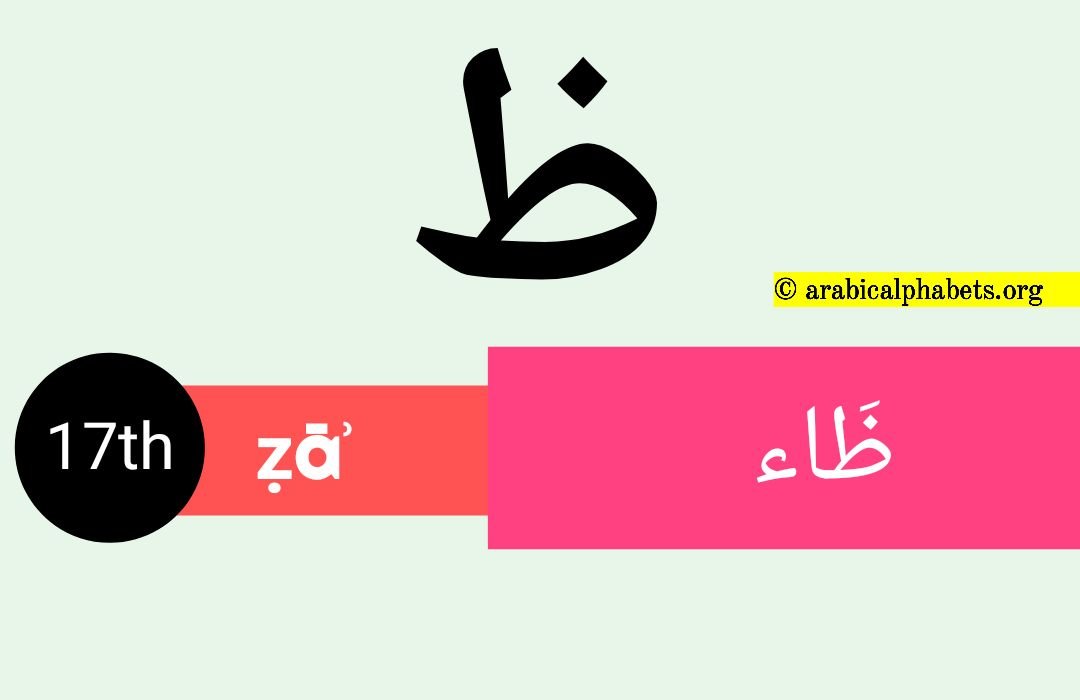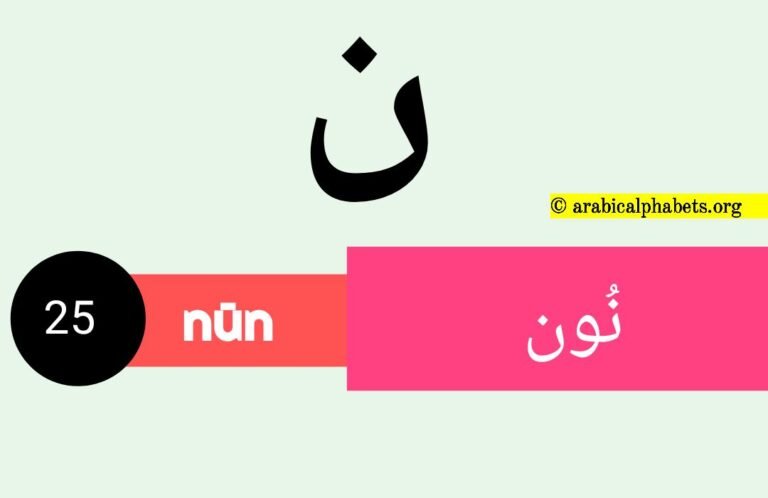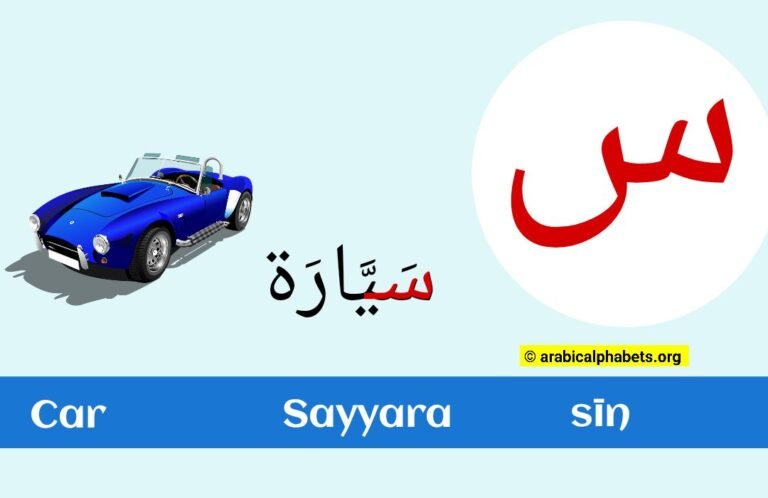Seventeenth Arabic Alphabet Letter
Have you ever found yourself scouring the internet for information on the elusive 17th letter of the Arabic alphabet? Look no further because we have the answer you’ve been searching for!
We will provide you with a clear photo of this mystifying character and reveal its place in the complete order of Arabic letters.
Whether you’re a language enthusiast, an aspiring calligrapher, or simply curious about alphabets from around the world, this article is your ultimate guide to unraveling the secrets of the Arabic script.
Seventeenth Arabic Alphabet Letter Full Details Here
Welcome to an in-depth exploration of the seventeenth letter of the Arabic alphabet, “Ẓāʾ” (ظ). This comprehensive guide will delve into its pronunciation, written form, usage, and cultural significance within the Arabic language.
1. Introduction to Ẓāʾ (ظ):
“Ẓāʾ” occupies the seventeenth position in the Arabic alphabet, contributing uniquely to the phonetics and structure of the language.
2. Pronunciation of Ẓāʾ:
“Ẓāʾ” is pronounced as a distinct sound not present in English. Position the tongue against the upper front teeth to articulate it and create a resonant “z” sound.
3. Written Form of Ẓāʾ:
The written form of “Ẓāʾ” (ظ) bears a distinct shape, setting it apart from other letters. Its visual representation adds depth to its significance.
4. Positional Variations:
“Ẓāʾ” appears in initial, medial, and final positions within Arabic words. Its form adjusts based on its location in a word.
5. Vocabulary and Usage:
You’ll encounter the letter “Ẓāʾ” in various words. Examples include “ظلام” (darkness), “ظريف” (clever), and “ظهر” (back).
6. Grammar and Language Structure:
Understanding the role of “Ẓāʾ” in Arabic grammar is pivotal for crafting precise sentences. It affects verb conjugations, noun-adjective agreements, and overall sentence construction.
7. Cultural and Linguistic Significance:
“Ẓāʾ” transcends its linguistic function, holding cultural significance in poetry, literature, and daily expressions. Exploring its role enriches your grasp of Arabic communication and cultural nuances.
8. Calligraphic Expressions:
Arabic calligraphy often features “Ẓāʾ” due to its distinct form. The diverse calligraphic styles allow artists to creatively interpret and enhance their visual appeal.
9. Writing Proficiency:
Enhance your writing skills by practicing the formation of “Ẓāʾ” in isolation and within words. Develop muscle memory to write the letter confidently.
10. Memorable Memorization:
Mnemonic techniques aid in memorizing “Ẓāʾ.” Associating the letter with vivid mental images fosters easier recall.
11. Progression to Reading:
Learn how “Ẓāʾ” combines with other letters to form words. Develop foundational reading skills, enabling you to decipher basic words and sentences.
12. Cultural Context:
Dive into the historical and cultural context of “Ẓāʾ.” Discover its evolution, usage across different linguistic scenarios, and role in shaping Arabic expression.
13. Practical Resources:
Utilize downloadable practice materials, audio resources, and supplementary tools to cater to your learning style and pace.
14. Path to Proficiency:
Mastering “Ẓāʾ” serves as a stepping stone in your Arabic journey. Gain insights into what lies ahead, whether advanced language skills or exploring regional dialects.
15. Enriched Language Appreciation:
Ultimately, your journey through the letter “Ẓāʾ” will cultivate a profound appreciation for the artistry of Arabic script, its influence on cultural expressions, and its role in connecting you with Arabic heritage.
By immersing yourself in the intricacies of the Arabic letter “Ẓāʾ,” you’re embarking on a path of language enrichment and cultural understanding that opens doors to effective communication and a deeper connection with the Arabic-speaking world.
Table Description -> A – Serial Number, B – Isolated Form, C – Trans-literation, D – Letter name, E – Letter Name In Arabic Script.
| A | B | C | D | E |
|---|---|---|---|---|
| 17 | ظ | ẓ | ẓāʾ | ظَاء |
Get 1 to 28 Arabic Letters Order
Table Description -> A – Serial Number, B – Isolated Form, C – Trans-literation, D – Letter name, E – Letter Name In Arabic Script.
| A | B | C | D | E |
|---|---|---|---|---|
| 1 | ا | ā | ʾalif | أَلِف |
| 2 | ب | b | bāʾ | بَاء |
| 3 | ت | t | tāʾ | تَاء |
| 4 | ث | th | thāʾ | ثَاء |
| 5 | ج | j | jīm | جِيم |
| 6 | ح | ḥ | ḥāʾ | حَاء |
| 7 | خ | kh | khāʾ | خَاء |
| 8 | د | d | dāl | دَال |
| 9 | ذ | dh | dhāl | ذَال |
| 10 | ر | r | rāʾ | رَاء |
| 11 | ز | z | zāy | زَاي |
| 12 | س | s | sīn | سِين |
| 13 | ش | sh | shīn | شِين |
| 14 | ص | ṣ | ṣād | صَاد |
| 15 | ض | ḍ | ḍād | ضَاد |
| 16 | ط | ṭ | ṭāʾ | طَاء |
| 17 | ظ | ẓ | ẓāʾ | ظَاء |
| 18 | ع | ʿ | ayn | عَيْن |
| 19 | غ | gh | ghayn | غَيْن |
| 20 | ف | f | fāʾ | فَاء |
| 21 | ق | q | qāf | قَاف |
| 22 | ك | k | kāf | كَاف |
| 23 | ل | l | lām | لاَم |
| 24 | م | m | mīm | مِيم |
| 25 | ن | n | nūn | نُون |
| 26 | ه | h | hāʾ | هَاء |
| 27 | و | w | wāw | وَاو |
| 28 | ي | y | yāʾ | يَاء |
Beginner’s Guide to Arabic Alphabets: Learn Letters with Ease
Welcome to the “Beginner’s Guide to Arabic Alphabets: Learn Letters with Ease.” This comprehensive guide is designed to introduce you to the Arabic alphabet, providing you with the foundational knowledge needed to navigate its intricate characters confidently. Let’s explore the full details of this user-friendly learning resource:
1. Introduction to Arabic Alphabets: Begin your journey with an overview of the importance of the Arabic alphabet in the language. Understand its role as the building blocks of Arabic communication.
2. Step-by-Step Learning Approach: The guide adopts a gradual approach, commencing with foundational concepts and introducing more intricate letters gradually. This incremental method ensures a smooth and comprehensible learning experience.
3. Pronunciation Made Simple: Accurate pronunciation is vital. The guide offers detailed explanations and audio resources for each letter’s distinct sound, helping you achieve accurate articulation.
4. Letter Forms and Variations: Delve into the different forms of each letter based on its position within a word: initial, medial, and final. Practice writing each form to reinforce your understanding.
5. Vocabulary Building: As you learn each letter, explore a curated list of words that feature it. This practical approach enhances your vocabulary and immediate application of what you’ve learned.
6. Cultural Context: Discover the cultural significance of Arabic letters and their role in poetry, literature, and everyday expressions. Gain insights into how language and culture intersect.
7. Writing Practice: Practice writing each letter in isolation and within words. Guided tracing and writing exercises help you develop confident handwriting skills.
8. Mnemonics for Memorization: Memorizing the Arabic alphabet is enjoyable with mnemonic techniques. Associating each letter with memorable images aids retention.
9. Formation of Basic Words: Learn how to combine letters to form simple words. This bridges the gap between individual letters and practical language usage.
10. Interactive Exercises: Engage in interactive exercises reinforcing letter recognition, pronunciation, and word formation. These activities make learning dynamic and effective.
11. Visual Resources: Visual aids, such as diagrams and charts, enhance your understanding of the alphabet’s structure and each letter’s forms.
12. Path to Further Learning: The guide guides where to continue your Arabic language journey after mastering the alphabet. Explore advanced language skills, dialects, and cultural nuances.
13. Cultural Enrichment: By understanding the Arabic alphabet, you’re gaining a deeper connection to the culture and heritage of Arabic-speaking communities. This knowledge enriches your language experience.
14. Practical Application: “Beginner’s Guide to Arabic Alphabets” provides a solid foundation for further language study. As you progress, you’ll find confidence in reading, writing, and communicating in Arabic.
This guide is your gateway to unlocking the beauty and intricacy of the Arabic alphabet. Following its systematic approach lays the groundwork for a fulfilling journey into Arabic language and culture. Embrace this beginner-friendly resource, and watch the Arabic alphabet unfold before you.
Conclusion Points
In conclusion, our comprehensive exploration of the seventeenth Arabic alphabet letter, “Ẓāʾ” (ظ), has illuminated its distinctive role within the Arabic language and its profound significance. By delving into its pronunciation, written form, grammatical implications, and cultural associations, we’ve gained valuable insights into its contributions to the richness of Arabic communication.
As you continue learning Arabic, remember that each letter, including “Ẓāʾ,” is a building block in your path toward proficiency. Embrace the uniqueness of “Ẓāʾ” as it enhances your understanding of cultural expressions, linguistic intricacies, and the broader scope of the Arabic-speaking world. With each letter you master, you’re moving closer to confidently engaging with the vibrant heritage and eloquent communication of the Arabic language.
Ten frequently asked questions (FAQs) about the seventeenth Arabic alphabet letter, “Ẓāʾ” (ظ):
Where does “Ẓāʾ” (ظ) stand in the Arabic alphabet?
“Ẓāʾ” is the seventeenth letter in the Arabic alphabet.
How do you pronounce “Ẓāʾ” (ظ)?
Pronouncing “Ẓāʾ” involves creating a sound not commonly found in English. Position your tongue against the upper front teeth and produce a resonant “z” sound.
What does the written form of “Ẓāʾ” (ظ) look like?
The written form of “Ẓāʾ” resembles the English letter “ẓ” and boasts a unique shape that distinguishes it from other letters.
In which positions can “Ẓāʾ” (ظ) appear within Arabic words?
“Ẓāʾ” can appear in initial, medial, and final positions within words, with its form adapting based on its position.
Could you provide examples of words containing “Ẓāʾ” (ظ)?
Certainly! Words like “ظلام” (darkness), “ظريف” (clever), and “ظهر” (back) incorporate the letter “Ẓāʾ.”
What role does “Ẓāʾ” (ظ) play in Arabic grammar?
Understanding “Ẓāʾ” is vital for constructing grammatically accurate sentences. It influences verb conjugations, noun-adjective agreements, and overall sentence structure.
Is “Ẓāʾ” (ظ) culturally significant?
Beyond its linguistic role, “Ẓāʾ” holds cultural importance in poetry, literature, and expressions, offering insights into Arabic communication and cultural heritage.
Does “Ẓāʾ” (ظ) appear in Arabic calligraphy?
Due to its unique shape, “Ẓāʾ” is frequently featured in Arabic calligraphy. Different calligraphic styles allow artists to interpret their designs creatively.
How can I practice recognizing and writing “Ẓāʾ” (ظ)?
Consistently practice writing “Ẓāʾ” in isolation and within words to enhance your recognition and integration of the letter.
Where can I access additional resources to learn about “Ẓāʾ” (ظ) and other Arabic letters?
Explore textbooks, online courses, language apps, and language exchange platforms to expand further your understanding of “Ẓāʾ” and other Arabic letters.
These FAQs provide a comprehensive understanding of the Arabic letter “Ẓāʾ.” By immersing yourself in its intricacies, you’re better equipped to navigate the Arabic language and culture world.






